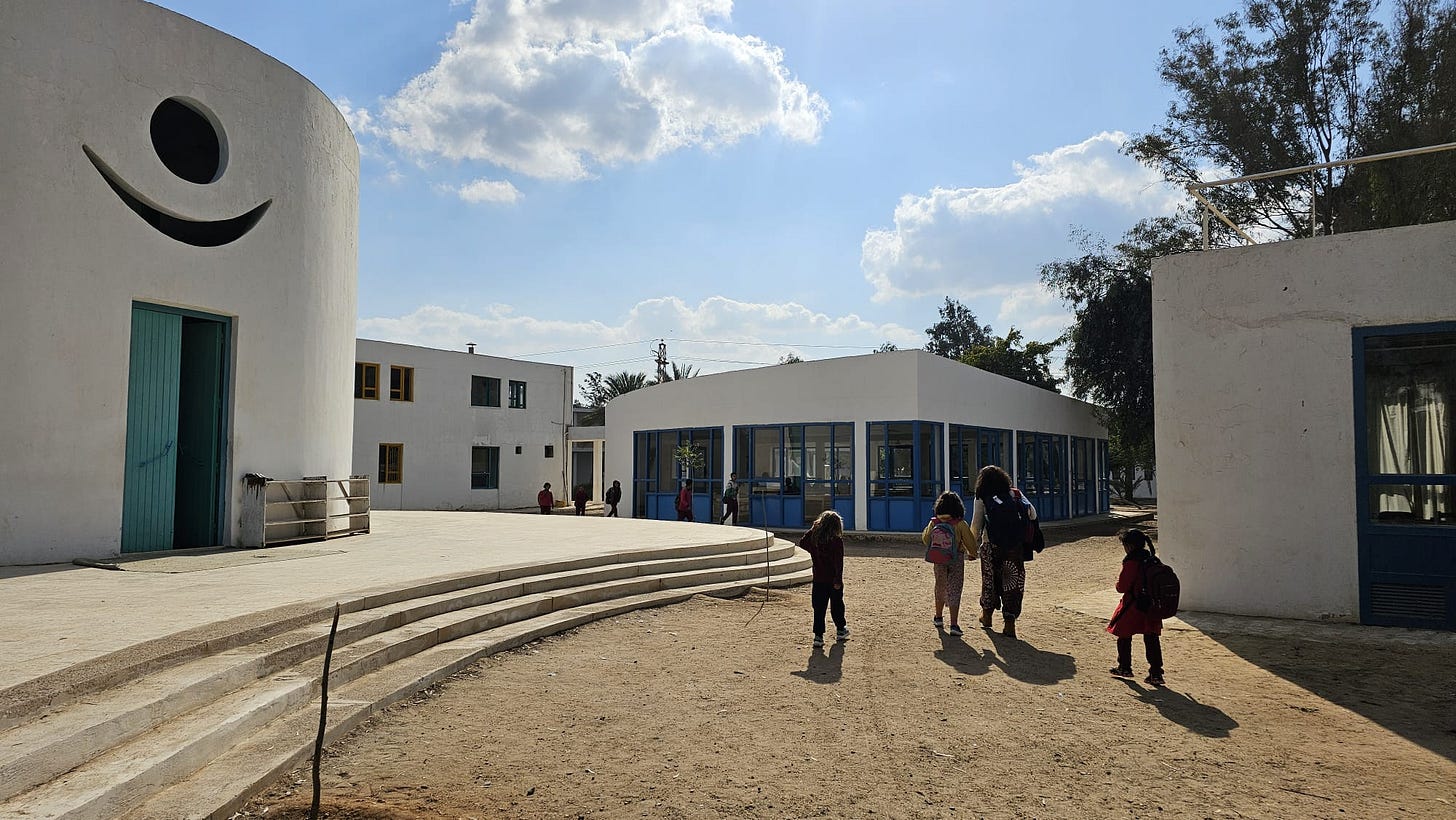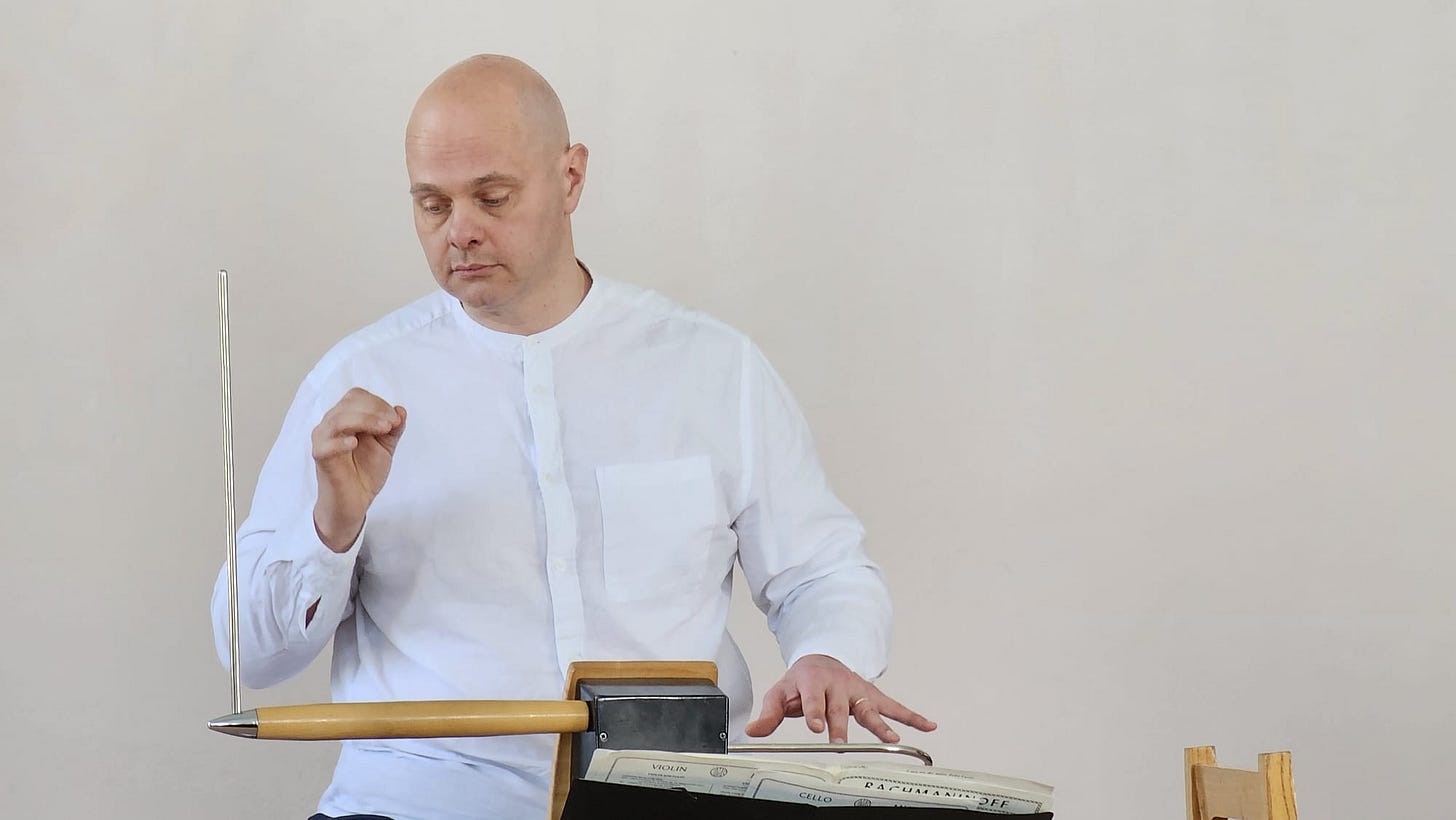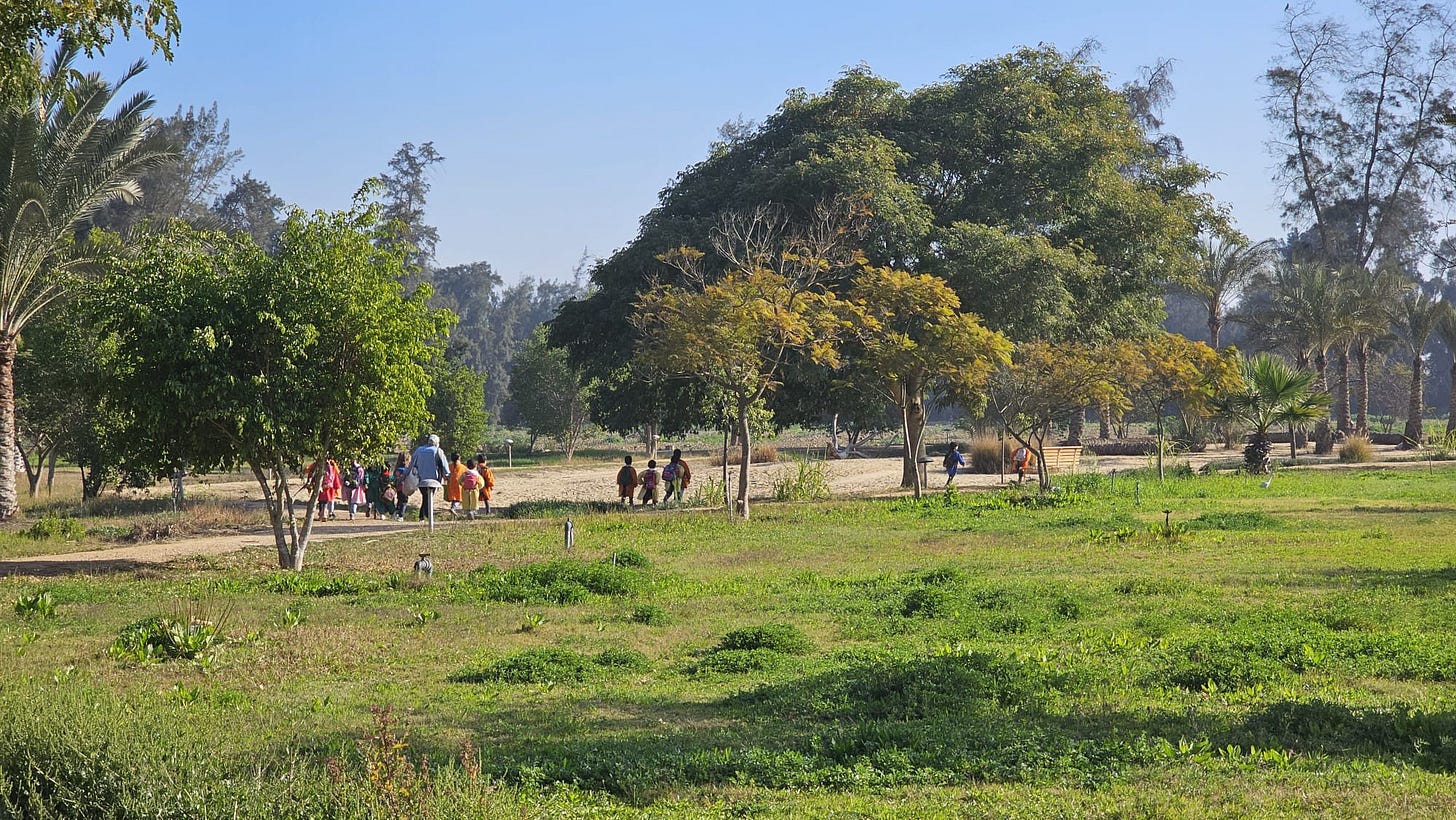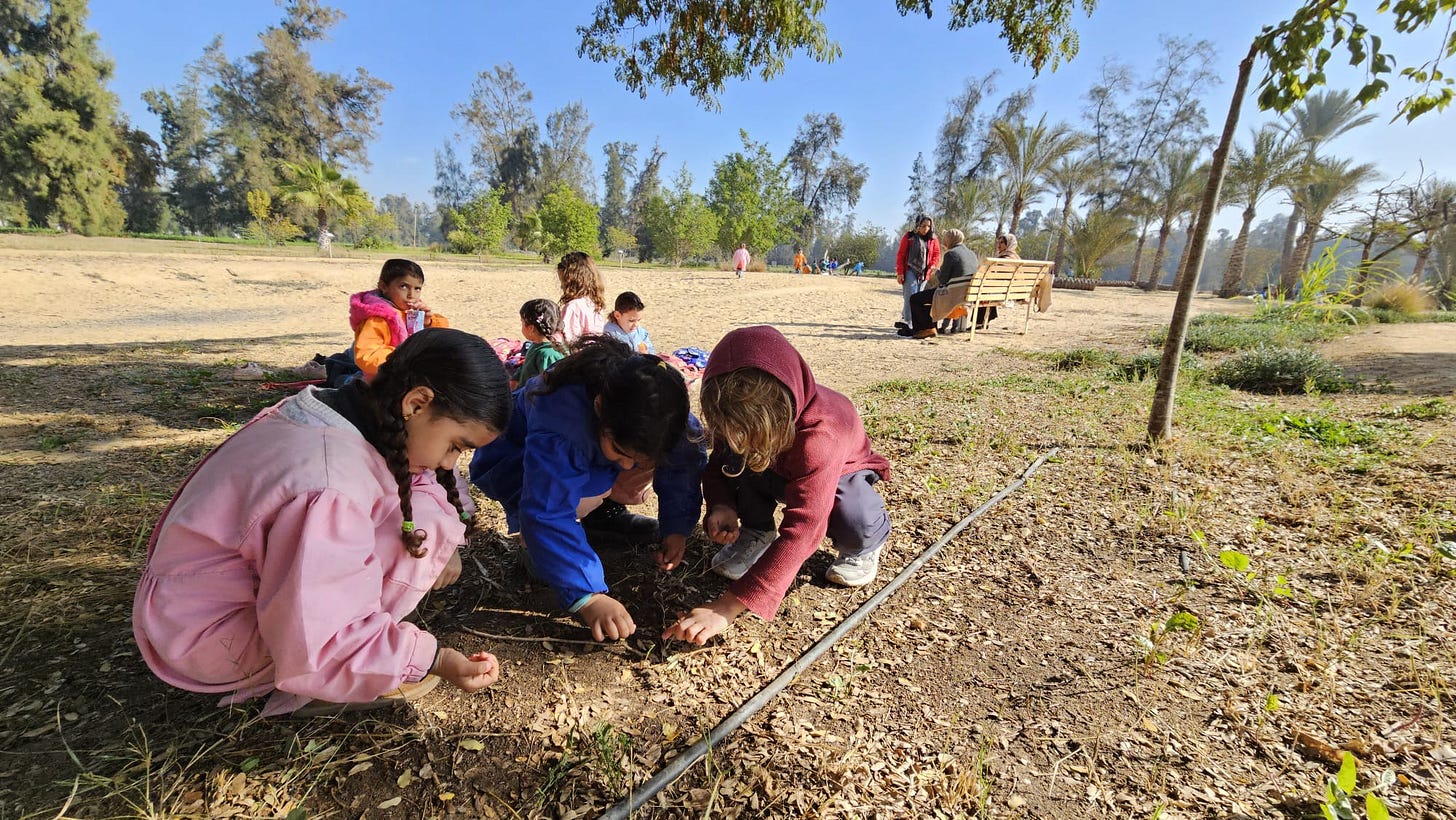This is is the second of a two-part series. Here is part one.
Within the SEKEM farm plot, the founders started a Waldorf-inspired school based on the Egyptian State Curriculum. It is taught entirely in Arabic, is well-resourced, and is mostly intended for and attended by locals from Bilbeis. Their Kindergarten started as a way to support the SEKEM working mothers and was so successful that it became an entrenched part of the school and the community.
Cole, the kids, and I weaved our way through a collection of white brick-and-mud buildings with blue and orange windowsills. The admin offices, the cafeteria, the mosque. They were mostly round, one-story high, and not densely packed. The first to third grade classrooms were part of the same structure forming a semi-circle facing a sand and gravel space with a nice wooden play structure and a tree planted right at the center. The younger grades playground. On the other side of that open space - in a separate structure that matched the younger grades’ building in form - were the kindergarten classrooms. We drop off Sina there and what his morning looks like is something of a mystery. Amina slips off to leave her bag in the third-grade classroom before joining the open-air morning assembly.
Every morning all grades convene in this space in a spiral around a tree planted right at the center. They start with a Steiner verse in Arabic and then the spiral disperses into partial concentric rings paralleling the early grade building behind them and facing the center of the playground. The tree. Behind the tree, a pole with the Egyptian and SEKEM flags stood tucked alongside some bushes and the kindergarten building. Every morning, three or four higher grade students face the ringed collective. One starts with a Qur’an verse and the others share tidbits from their class or about the world. As these students slip back with their respective grades, two middle graders then walk out with trumpets. They play the national anthem and everyone sings along. The morning ritual ends with a younger grade student walking out, facing the flag, and chanting tahya gomhoreyyet masr el arabeyya (تحيا جمهورية مصر العربية) - long live the Republic of Egypt – three times. The collective disbands with each grade filing in front of their class and their teachers greeting each student with a handshake before they enter the classroom.
Though some specifics were different (the circular form, the Steiner verse, the morning handshake), the overall form of this morning process was similar to how I experienced school at their age. That made me glow inside. Many a times back in Viroqua the kids would share something they did at school – a song, a handwork project, a Eurythmy reference, something – that would prompt Cole to ruminate with an “ohhh I remember when I did that”. Though I loved that connection they had with their dad’s childhood, I couldn’t help but be sad that they didn’t really have any such experiences that echoed my childhood. Finally, the seed of a school memory was planted that bridged their childhood experience to mine. Critically, it also bridged it to that of other Egyptian kids. I was probably beaming way too eagerly for the mundanity of such a morning assembly. But I couldn’t help it.
Amina is more vocal in her reflections so I got more glimpses of what her day at SEKEM looked like. They had math in Arabic (technically Hindu) numerals which was difficult for her to decipher. Luckily though, according to her teacher, third grade is when they switch from the Hindu numerals (١، ٢، ٣) to the Arabic ones (1,2,3) and soon after she joined, they switched. She would tell me they took the moheet (محيط) which in Arabic can mean ocean. To that I respond, “nice Beano you’re taking geography”. She shook her head no “moheet el moraba’” (محيط المربع). Moheet could also mean perimeter in Math. They were learning about the perimeter of a square. It was a funny moment. I took Math in English and wasn’t really familiar with the Math terms in Arabic. And I was thrilled she was getting the exposure and schooling me. For movement or PE, they played relay games out in the big field and I heard her classmates cheer “Amina Amina” as she ran off with a cone-balanced ball.
All grades had lunch at the same cafeteria, but they staggered their presence starting with the younger grades. They always began their meals with a lovely verse expressing gratefulness for the bread they eat and, importantly, acknowledging it as a privilege that many others don’t get. Later, I asked Amina’s class if I could record them singing the verse so we could incorporate it into our routine back in Viroqua. The kindergardners ate the same food but in their own classrooms. I loved that the kids had different Egyptian dishes - loubiya, messaqa’a, cooked spinach. I was pleasantly surprised by how Amina described the eggplant dish as delicious. She hardly ever tries eggplant when I make it and I do not recall her every describing it as delicious. After lunch, the third graders went and prayed in the school mosque. Though I have complicated feelings towards how we’re taught religion in school, I still appreciated the exposure and the rhythm of it. Another bridge to my background.
The ghaba (الغابة), the woods, was a reoccurring popular activity. An open area, well shaded by a thicket of trees. It had a big fire pit and a few wooden tables with tree logs for chairs. Grades went there as part of their recess. Sina also went to the ghaba and was super eager to tell me about it the first time he went. He dragged me from my hands all the way there and asked us if we could bring Vivi and Gedo and Ahmed and Salah (my parents and brothers) and all have a picnic there.
One day Amina made me burst out laughing as she said “mama listen to this”:
yalla ya ahlaweyya, ooh aha. sheddo helko shwayya. ooh, aha.
يالا يا اهلاوية.اوه. اها. شدوا حلكوا شوية. اوه. اها
Let’s go Ahly fans, ooh aha. You can do better. Ooh, aha.
Debb el ard tetla’ nar, faree’ el sanawy faree’ gabbar
دب الأرض تطلع نار، فريق الثانوي فريق جبار
Stomp the ground, fire comes blazing, the high schooler team is pretty amazing.
Apparently, her class went to cheer the high schoolers - sanaweya (ثانوية) - playing football. Ahly is a massively popular Egyptian football team. The cheers she repeated were endearing and hilarious.
Another endearing memory was when I saw Amina sitting in a tree with one of her favorite friends – Renad. She was little and funny (كوميكية اوي Amina said) and was really sweet to Beano. She let Amina borrow her pink and maroon school uniform for her last day because it was also yom el-masrah (يوم المسرح) or theater day and their class was presenting.
Every Thursday was a theater day.
At the end of every Thursday, everyone gathered in the theater room – a simple and spacious room with tall ceilings and big windows. Even the kindergartners joined. We only had two Thursdays there. It always starts with a young man reading Qur’an in a beautiful melodic voice that gave me goosebumps. Then there is a musical performance. Our first Thursday featured Dutch visitors playing the Theremin and the piano and took up the whole half hour allotted to the affair. I had never even heard of this Theremin and it was pretty darn cool seeing someone create music literally out of thin air. It felt oddly surreal being exposed to that niche European instrument in rural Egypt.
The second Thursday, our last day, was more typical in that there was a shorter musical performance but then grades also presented. The performance was by Europeans again - a trio this time. It was certainly lovely, but I couldn’t help but wonder if every performance the kids were exposed to was conducted by Europeans. If it was, that would make me uncomfortable to say the least. Despite the good intentions, it would carry some distinctly orientalist overtones. For me at least. I should’ve asked. Anyways, it was too small of a sample size to tell. After all, we were only there twice.
After the music, the third and second graders performed. Amina joined as they played Alouette - a French song - on the flute and then sang Do-a-Deer in English and Arabic. Their performances were accompanied by a marvelous Egyptian pianist. I was smiling so hard my cheeks hurt. The day then ends with an early dismissal – around 12:30 pm.
Thursdays also began in a special way. The school day starts with a big circle in a spot near the NatureTex factory, some 5-minute walk from the school premises. In addition to students and teachers from the school, employees and workers from all the different SEKEM companies and social initiatives join. Helmy Abouleish, the son of the founder Ibrahim Abouleish and the current CEO of SEKEM Holding joins with his German wife, Konstanze. Visitors, like us, were welcome to join. There were a few others, almost all foreigners as far as I can tell. Though the existence of foreigners in Egyptian private schools was not in itself an uncommon feat, what was unique here (to my eyes at least) was that their presence in this school was not meant for middle/upper class Cairene kids. It was for less privileged residents of a governorate other than Cairo. Everyone starts with a Steiner verse in Arabic and then Abouleish calls on different SEKEM initiatives and a representative leads another verse. The whole affair takes then less than 10 minutes, and the students then proceed with their day.
For Sina, Thursdays meant a morning walk and a picnic where they get to share buns they made together the day before. Cole and I ran into Sina on our last day. We too start our day with a morning walk around the beautiful SEKEM premises before we settle somewhere on their estate to work for the day. Because the school is so far away – about an hour and 15-minute drive each direction, we knew that we wouldn’t do drop off, drive back and then return for pick up. So we asked if we could stay there during the school day and they very amicably obliged. Our walks were serene and delightful. The trails were simple and well maintained. Sometimes we walked towards the impressive brick and mud amphitheater. Others we wandered towards the hotel and the SEKEM stores. Often framed by palm trees and stone pines, the trails meandered between different plots of lands. Some commercial-sized for the herbs they used for their teas. Chamomile, anise, za’atar. Others were smaller gardens, closer to the school with marked rows. Eggplants, dill, tomatoes, pomegranate, arugula. Pigeons fluttered around classically Egyptian white dovecots. Egrets or Abu Erdan (أبو قردان) promenaded in the fields. Dewdrops made everything shine and morning mist added mystique to our stroll.
Sina came running towards me with a chunk of bread. “Try this. It has cheese in it!” he said enthusiastically as he shoved it in my face. Last Thursday he came back with some 5 little buns, one for each member of our family. The sun had burnt off the morning mist by then. It was warm and splendid and I was attacked by a wave of pure quiet contentment. I followed him taking it all in. “This is beautiful isn’t it. Did we accidentally fall into heaven or what,” I asked rhetorically. “ah. Yes, we did,” Sina said nonchalantly as he pulled me to the sandy play area where the rest of his group were parked.
For sure the main downside is how far away the school is from where we stay in Cairo. Other than the hassle of having to drive so much every day and the inconvenience of having to work from there (though it was a delightful set up, it’s not a particularly productive one for work), I was mainly worried about damaging the cars we were borrowing from my parents. With my dad’s substantial help, we bought the 2011 Chevy Cruz when we lived in Egypt 2014-2017. It has barely been functioning the past few years, but neither we nor my parents could afford to buy a new car. So instead, they’ve been sinking money into fixing it. With the currency crises and stark devaluation of the Egyptian pound, the latest iteration of which began in 2021/2022, the car market has been insane. The EGP which stood at 6/7 pounds to the dollar when Cole and I were in college (late 2000s) is now at an official market rate of 30 pounds to the dollar. The black-market rate is double that and reached a peak last month of 70 pounds to the dollar. Though it has dropped with the promise of a massive influx of foreign currency through last week’s Ras el-Hikma deal and the currency is expected to stabilize in the near future. Still. If the car breaks down, it will be near impossible to replace it without adding significant financial strain on my parents.
Unfortunately, the Chevy did break down. By the end of the first week, it was no longer reliably accelerating and needed to be fixed for umpteenth time.
We tried finding an alternative to using my parents’ cars. My dad knew an uber driver and we arranged with him to pick us up from my parents’ at 6:45 am and then again at the end of the day from SEKEM at 2:30 pm. After doing the trek one direction though, the driver apologized and said he misunderstood how far the destination was. He wouldn’t even come back to pick us up. It was an exciting adventure finding alternative means of transportation back. We took the teachers’ school bus to the nearest microbus station in town. Then we took two different microbuses – the transportation of choice for most Egyptians without means - to bring us closer to New Cairo where Salah, my youngest brother, came to pick us up. The whole trip back took around 3 hours. I was impressed with how well the kids did, given that it was an unexpected turn of events at the end of a school day on just their second day in. But it would’ve been unsustainable to budget a 5-6 hour commute every day.
As a result of this, midway through that first week, I was exhausted and was questioning whether this experiment was worth the effort. That same day though, after all three kids were tucked in, I heard Sina whispering something to himself in the dark. He was singing a verse in Arabic. I smiled to the dark room, eyes closed. By the end of the two weeks, I reflected on all the little moments. One of Sina’s new friends calling on him and holding her palm open as we picked him up. Sina smiling and wordlessly unzipping his backpack, rummaging for something and handing his friend a bracelet that she then proceeded to hand to another. (What was that all about?) Amina humming belady belady – the national anthem - to herself at random points during the day. Sina collecting little snails with his friends. Amina sitting with her class at the cafeteria chatting and giggling. For sure, the kids grumbled about things. They missed their school and their friends. They did not like this or that at SEKEM. My version of how this experiment went is likely starrier than theirs. But ease and comfort were never really the goal. For my purposes, I considered this round of the experiment a success. And would do it again next year in a heartbeat.










Gosh, these are so interesting
Beautiful reflections.